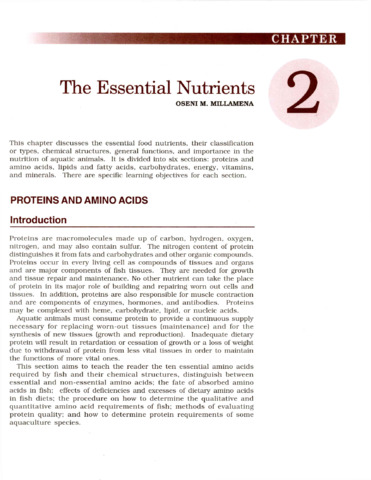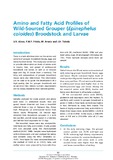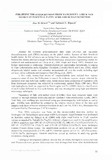Lipid nutrition studies on grouper (Epinephelus coioides) larvae
- Global styles
- MLA
- Vancouver
- Elsevier - Harvard
- APA
- Help

View/
Date
2004Author
Page views
8,927ASFA keyword
AGROVOC keyword
Metadata
Show full item record
Share
Abstract
The main objectives of this project were to study the lipid chain transfer from the egg stage through hatching and the patterns of lipid conservation or loss during starvation and feeding of larvae in order to elucidate the lipid metabolism of grouper (Phase 1); to determine the fatty acid composition of highly unsaturated fatty acid (HUFA) boosters and enriched live food organisms to enable the possibility of choosing food organisms that provide various dietary levels and ratios of docosahexaenoic acid (DHA), eicosapentaenoic acid (EPA) and arachidonic acid (ARA, Phase 2); and to determine the effect of Brachionus and Artemia, containing different levels and ratios of DHA:EPA:ARA, on the growth and survival of grouper larvae (Phase 3). Total lipids (TL) of samples were extracted and separated into neutral (NL) and polar lipids (PL). The samples collected in Phase 1 were floating neurula eggs, newly hatched (NHL) and unfed 4-day larvae; larvae fed with live food organisms for 25 and 35 days or starved for 3 days; and wild-sourced larvae starved for a week. In Phase 2, the samples collected were phytoplanktons, Brachionus cultured in phytoplankton for 4 days, Diaphanosoma celebensis and Pseudodiaptomus annandalei. In phase 3, larvae were fed Brachionus until day 14 and at day 25 with Artemia. E. coioides eggs contained high DHA, EPA and ARA, demonstrating their importance in larval development. Larvae primarily spent NL as energy, whereas PL was generally conserved. Wild grouper larvae had higher levels of PL than NL, whereas hatchery-sourced eggs and larvae contained higher levels of NL than PL. Based on the lipid content of wild larvae, high phospholipid diets were essential for larvae survival and normal development. A variety of products were effective in enriching the HUFA content (particularly ratios of DHA, EPA and ARA) of live food organisms. HUFA-enriched live food organisms enhanced the growth, survival and pigmentation in grouper larvae.
Suggested Citation
Alava, V. R., Priolo, F. M. P., Toledo, J. D., Rodriguez Jr., J. C., Quinitio, G. F., Sa-an, A. C., … Caturao, R. D. (2004). Lipid nutrition studies on grouper (Epinephelus coioides) larvae. In M. A. Rimmer, S. McBride, & K. C. Williams (Eds.), Advances in grouper aquaculture (pp. 47–52). Canberra: Australian Centre for International Agricultural Research.
Type
Book chapterISBN
9781863204385Series
ACIAR Monograph 110Collections
- Books and Book Chapters [123]
Related items
Showing items related by title, author, creator and subject.
-
The essential nutrients: Proteins and amino acids
Millamena, Oseni M. (Aquaculture Department, Southeast Asian Fisheries Development Center, 2002)This section aims to teach the reader the ten essential amino acids required by fish and their chemical structures, distinguish between essential and non-essential amino acids; the fate of absorbed amino acids in fish; ... -
Series: ACIAR Monograph 110
Amino and fatty acid profiles of wild-sourced grouper (Epinephelus coioides) broodstock and larvae
Alava, Veronica R.; Priolo, Flora Mae P.; Toledo, Joebert D.; Rodriguez, Jesus C., Jr.; Quinitio, Gerald F.; Sa-an, Analyn C.; de la Peña, Milagros R.; Caturao, Romeo D. (Australian Centre for International Agricultural Research, 2004)This study was undertaken to provide information on the levels of amino acids in the muscle, liver and gonad of wild-sourced broodstock and larvae, as well as in neurula eggs and day 35 larvae from a hatchery. The fatty ... -
Philippine thraustochytrids from mangroves: A rich new source of essential fatty acids for human nutrition
Oclarit, Jose M.; Hepowit, Nathaniel L. (Marine Science Institute, University of the Philippines, 2007)




